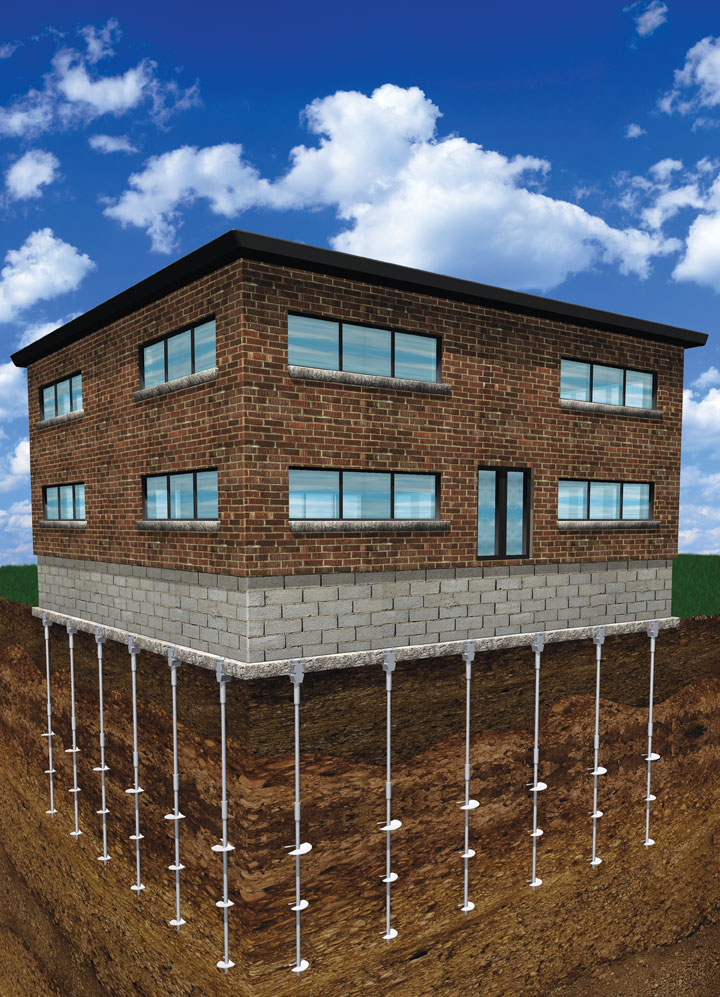Foundation Repair Using Helical or Push Piers
Concrete Piers
Concrete piers are short, blunt concrete cylinders that are driven into the soil, stacked on top of each other and held together by a wire. Shims are placed atop the uppermost concrete cylinder and the soil is backfilled. These concrete piers are wide in diameter, anywhere from six to eight inches, and can be difficult to drive deep into the ground. Unfortunately, there is nothing to guide the piers as they are installed, often resulting in crooked or uneven settling of the cylinders, which can create further settling issues for your home. Also, the concrete material is susceptible to cracking and breaking due to the pressure and weather changes, so you may have to end up replacing these after time.
Steel Push Piers (Resistance Piers)
 Steel push piers, also called resistance piers, are driven deep into the soil to the most stable soil layer. A heavy-duty steel bracket is installed below and against your foundation’s footing, and then steel pier sections are hydraulically pushed through the bracket to the bedrock. The weight of your home is transferred through these piers to the competent soil below. If soil conditions are unknown, these push piers are a good choice for your home, because the steel makes them durable and reliable. If you have a lighter structure, like a deck or shed, that needs to be repaired, Helical Piers would be your best option.
Steel push piers, also called resistance piers, are driven deep into the soil to the most stable soil layer. A heavy-duty steel bracket is installed below and against your foundation’s footing, and then steel pier sections are hydraulically pushed through the bracket to the bedrock. The weight of your home is transferred through these piers to the competent soil below. If soil conditions are unknown, these push piers are a good choice for your home, because the steel makes them durable and reliable. If you have a lighter structure, like a deck or shed, that needs to be repaired, Helical Piers would be your best option.
Helical Piers
 Helical piers are another multiple-part steel piering system. First, the helical pier section that has one or more helical blades welded into the shaft is inserted into the ground. Once the proper depths are achieved, heavy-duty steel foundation brackets are positioned below and against the footing. The weight of your home is then transferred through these piers to the deeper, competent soils to stabilize your home. Helical piers are the best possible solution for your home, if there is knowledge of property soil conditions. These piers are a great solution for many areas of the home, including light-weight structures such as decks that may have settled.
Helical piers are another multiple-part steel piering system. First, the helical pier section that has one or more helical blades welded into the shaft is inserted into the ground. Once the proper depths are achieved, heavy-duty steel foundation brackets are positioned below and against the footing. The weight of your home is then transferred through these piers to the deeper, competent soils to stabilize your home. Helical piers are the best possible solution for your home, if there is knowledge of property soil conditions. These piers are a great solution for many areas of the home, including light-weight structures such as decks that may have settled.
Foundation Supportworks helical pier system adheres strictly to the guidelines laid out by the International Code Council, which is the association responsible for developing the codes used to construct both residential and commercial buildings. Two problem areas that arise from faulty helical piers are improper shape of helix bearing plates, which can end up disturbing soil, and the improper tolerance allowances for couplers that connect the helical sections, which can create too much weight on the couplers when it should rest on the more durable pier shafts. Unfortunately, some manufacturers do not follow the ICC’s guidelines and thus homeowners are left with foundation problems that should have been repaired. Foundation SupportWorks helical pier systems are designed specifically according to the criteria outlined by the ICC, meaning these systems will perform as promised!
Contact us today for a free estimate on stabilizing your foundation!










